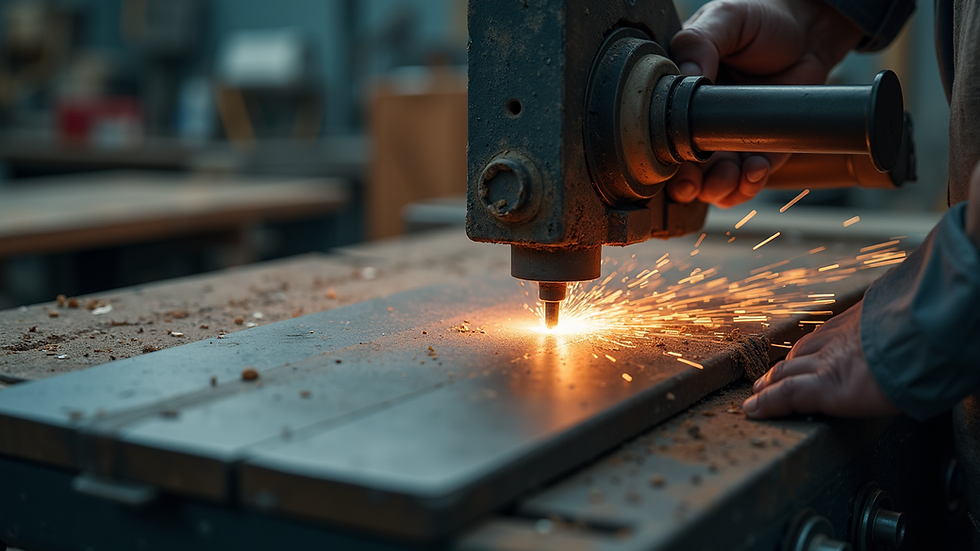The Essential Role of a Lapidary Saw
- Philix Chen
- Oct 20
- 4 min read
Working with hard materials like glass, ceramics, and gemstones demands precision and reliability. In these industries, the right tools can make all the difference. One such indispensable tool is the lapidary saw. This machine is designed to cut, shape, and prepare materials with accuracy and efficiency. In this post, I will walk you through the essential role of a lapidary saw, its benefits, and how to choose the best machine for your needs.
Understanding the lapidary saw benefits
The lapidary saw offers several advantages that make it a must-have for professionals working with tough materials. First, it provides precise cutting. Unlike traditional saws, lapidary saws use diamond blades that can slice through hard stones and ceramics without cracking or chipping. This precision is crucial when working on delicate projects where every millimeter counts.
Second, the lapidary saw enhances efficiency. Its powerful motor and specialized blade allow for faster cutting compared to manual methods. This speed does not come at the cost of quality; the cuts remain clean and smooth, reducing the need for additional finishing work.
Third, the saw is versatile. It can handle a wide range of materials, from soft stones to tough ceramics and glass. This flexibility means you can use one machine for multiple applications, saving space and investment costs.
Finally, the lapidary saw improves safety. Its design includes features like water cooling systems that reduce dust and heat, protecting both the operator and the material. This makes it a safer choice compared to dry cutting methods.

Key features to look for in a lapidary saw
When selecting a lapidary saw, several features should guide your decision. Understanding these will help you choose a machine that fits your specific needs.
Blade Size and Type
The blade size affects the thickness and size of the material you can cut. Larger blades handle bigger pieces but may be less precise for small cuts. Diamond blades are the standard due to their durability and cutting ability.
Motor Power
A powerful motor ensures smooth operation and the ability to cut through hard materials without stalling. Look for motors with sufficient horsepower for your typical projects.
Water Cooling System
This system keeps the blade cool and reduces dust. It extends blade life and improves safety by minimizing airborne particles.
Adjustable Cutting Angles
Some saws allow you to tilt the blade or the table to make angled cuts. This feature is useful for creating complex shapes and designs.
Build Quality and Stability
A sturdy frame reduces vibrations, leading to more accurate cuts. Check for machines made with durable materials and solid construction.
Ease of Maintenance
Machines that are easy to clean and maintain will save time and money in the long run.
What is the best lapidary machine for beginners?
For those new to working with hard materials, choosing the right lapidary saw can be overwhelming. Beginners need a machine that balances ease of use with professional capabilities.
A good beginner lapidary saw should have:
User-friendly controls: Simple on/off switches and clear settings help avoid confusion.
Safety features: Guards, water cooling, and stable bases prevent accidents.
Moderate blade size: A 6 to 8-inch blade is versatile and manageable.
Affordable price: Entry-level models provide good value without compromising quality.
One example is the Master Lap series, which offers reliable performance and is designed with beginners in mind. It includes features like adjustable cutting angles and a water cooling system, making it easier to learn and grow your skills.

Practical tips for using a lapidary saw effectively
Using a lapidary saw correctly ensures the best results and prolongs the life of your equipment. Here are some practical tips:
Always use water cooling: This prevents overheating and reduces dust.
Secure your material: Use clamps or a stable surface to avoid movement during cutting.
Wear protective gear: Safety glasses and gloves protect you from debris.
Start with slow cuts: Let the blade do the work; forcing the material can cause damage.
Regularly check the blade: Replace or sharpen blades when they become dull.
Clean the machine after use: Remove debris and dry the saw to prevent rust.
Following these steps will help you maintain precision and safety in your work.
Expanding your capabilities with advanced lapidary saws
As your projects become more complex, you might consider upgrading to advanced lapidary saws. These machines offer features like:
Multiple blade options for different materials.
Computerized controls for precise measurements.
Larger cutting tables for bigger pieces.
Enhanced dust collection systems for cleaner workspaces.
Investing in such equipment can increase productivity and open new possibilities in design and fabrication.

Final thoughts on choosing and using a lapidary saw
Selecting the right lapidary saw is a critical step in achieving quality results in your work with glass, ceramics, and stones. Its benefits in precision, efficiency, versatility, and safety make it an essential tool. By understanding the key features and following best practices, you can maximize your investment and improve your craftsmanship.
Whether you are starting out or looking to upgrade, there is a lapidary saw designed to meet your needs. Take the time to research, test, and maintain your equipment. This approach will ensure your projects are successful and your tools remain reliable for years to come.




Comments